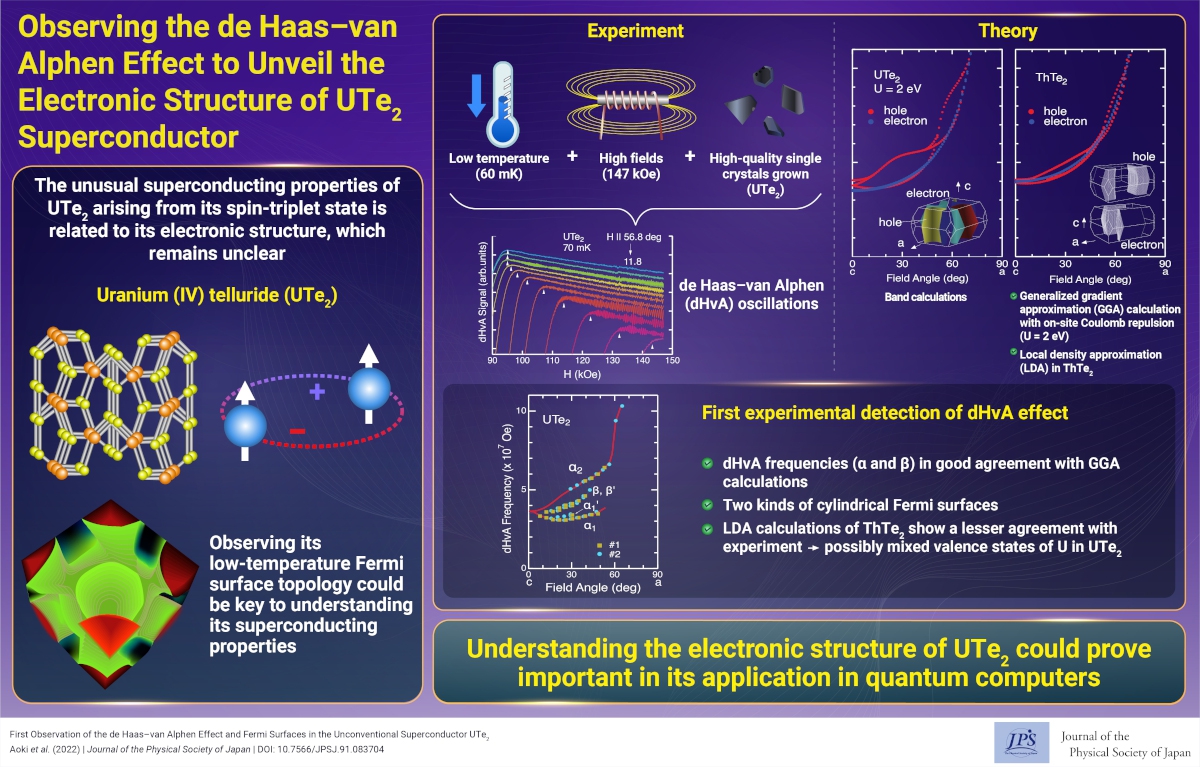Observing the de Haas–van Alphen Effect to Unveil the Electronic Structure of UTe2 Superconductor
© The Physical Society of Japan
This article is on
First Observation of the de Haas-van Alphen Effect and Fermi Surfaces in the Unconventional Superconductor UTe2
J. Phys. Soc. Jpn.
91,
083704
(2022)
.
The topology of Fermi surfaces with heavy effective masses in strongly correlated topological superconductor UTe2 was investigated using quantum oscillation measurements and theoretical calculations.

Heavy fermion UTe2 is one of the hottest topics in condensed matter physics. This is because of its unconventional superconducting properties, such as high field-reentrant superconductivity and multiple superconducting phases under pressure. Superconductivity is achieved owing to the formation of superconducting Cooper pairs of electrons. In UTe2, the unconventional pairing mechanism must be responsible for this; thus, the spin-triplet state is expected. It is crucial to investigate the electronic state microscopically, that is, to determine the Fermi surfaces using a microscopic experimental probe combined with a band theory.
A powerful experimental probe is the quantum oscillation measurement method, such as the de Haas–van Alphen (dHvA) effect, which is the oscillatory effect in magnetization caused by the quantization of cyclotron motions in high magnetic fields. Three conditions must be satisfied to detect quantum oscillations: low temperature, high magnetic field, and high-quality single crystals. These are somewhat difficult experimental conditions. In particular, high-quality single crystals are inevitably crucial for UTe2 with strong electronic correlations.
In this study, we grew the ultrapure single crystals of UTe2 using “a new recipe” of a single crystal growth technique, as demonstrated by a high and sharp superconducting transition in specific heat measurements. Using this high-quality single crystal, we successfully detected quantum oscillations (the dHvA effect) for the first time in UTe2. By rotating the field directions, the topology of Fermi surfaces is precisely determined experimentally. The results are consistent with the band structure calculations, indicating the existence of two types of cylindrical Fermi surfaces from the hole and electron bands. The dHvA signals are detected only at extremely low temperatures below 0.12 K, revealing the heavy effective mass resulting from strong electronic correlations.
The bare band structure calculations based on the 5f-itinerant model predict a small bandgap at the Fermi energy level, indicating a Kondo insulator. This is inconsistent with the real system because UTe2is a good metal with a large carrier number. To explain the experimental results obtained from the band calculations, we need to introduce the onsite Coulomb interaction, U. This suggests a possible mixed valence state of UTe2.
As Fermi surfaces, known as the “face of metal,” are essential information for the electronic states, our results are a good starting point for clarifying unusual phenomena in UTe2 and other unconventional superconductors.
(Written by D. Aoki on behalf of all the authors.)
First Observation of the de Haas-van Alphen Effect and Fermi Surfaces in the Unconventional Superconductor UTe2
J. Phys. Soc. Jpn.
91,
083704
(2022)
.
Share this topic
Fields
Related Articles
-
Fractional Vortex Array with Nontrivial Topological Structure Realized at Twin Boundary of Nematic Superconductor
Superconductivity
2025-3-24
Analysis of the two-component Ginzburg-Landau theory suggests that a conventional vortex is transformed into two fractional vortices with the topological nature of core-down and core-up merons at the twin boundary of a nematic superconductor.
-
Exploring the Vibrant Interplay of Machine Learning and Physics
Cross-disciplinary physics and related areas of science and technology
Electron states in condensed matter
Elementary particles, fields, and strings
Mathematical methods, classical and quantum physics, relativity, gravitation, numerical simulation, computational modeling
Statistical physics and thermodynamics
Superconductivity
2025-3-13
This Journal of the Physical Society of Japan Special Topics edition explores how physics and machine learning complement each other and can solve unresolved problems in physics.
-
Excitonic Insulators: Challenges in Realizing a Theoretically Predicted State of Matter
Electron states in condensed matter
Electronic transport in condensed matter
2025-3-3
The realization of an excitonic insulator can help in the establishment of a new electronic state in condensed matter physics, one that has the potential to exhibit novel electric, magnetic, and optical responses beyond those of conventional materials.
-
Shaping the Future of Materials Science with Tanabe–Sugano Diagrams
Dielectric, optical, and other properties in condensed matter
Electron states in condensed matter
Electronic structure and electrical properties of surfaces and nanostructures
Magnetic properties in condensed matter
2025-1-21
This special collection published in the Journal of the Physical Society of Japan celebrates 70 Years of Tanabe–Sugano Diagrams, highlighting their continued role in advancing materials with transition metals.
-
How to Construct a 3D Dirac Semimetal by Stacking 2D Massless Dirac Fermion Layers
Electron states in condensed matter
Electronic structure and electrical properties of surfaces and nanostructures
2025-1-14
Interlayer spin–orbit coupling originating from the anion potential gives rise to a 3D Dirac semimetal state that preserves inversion symmetry in the multilayer organic massless Dirac fermion system α-(ET)2I3.




